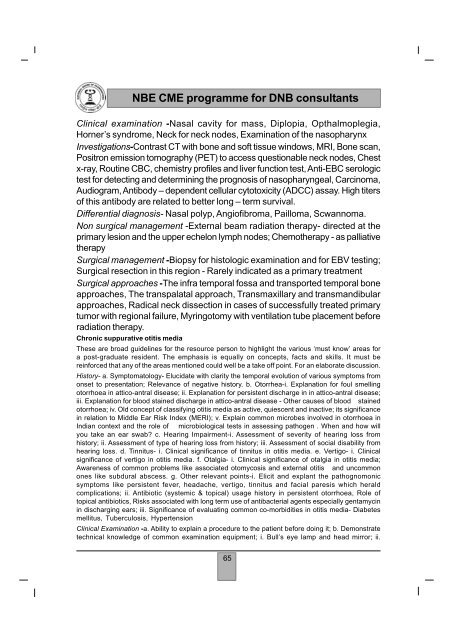NBE CME programme for DNB consultants - National Board Of ...
NBE CME programme for DNB consultants - National Board Of ...
NBE CME programme for DNB consultants - National Board Of ...
You also want an ePaper? Increase the reach of your titles
YUMPU automatically turns print PDFs into web optimized ePapers that Google loves.
<strong>NBE</strong> <strong>CME</strong> <strong>programme</strong> <strong>for</strong> <strong>DNB</strong> <strong>consultants</strong>Clinical examination -Nasal cavity <strong>for</strong> mass, Diplopia, Opthalmoplegia,Horner’s syndrome, Neck <strong>for</strong> neck nodes, Examination of the nasopharynxInvestigations-Contrast CT with bone and soft tissue windows, MRI, Bone scan,Positron emission tomography (PET) to access questionable neck nodes, Chestx-ray, Routine CBC, chemistry profiles and liver function test, Anti-EBC serologictest <strong>for</strong> detecting and determining the prognosis of nasopharyngeal, Carcinoma,Audiogram, Antibody – dependent cellular cytotoxicity (ADCC) assay. High titersof this antibody are related to better long – term survival.Differential diagnosis- Nasal polyp, Angiofibroma, Pailloma, Scwannoma.Non surgical management -External beam radiation therapy- directed at theprimary lesion and the upper echelon lymph nodes; Chemotherapy - as palliativetherapySurgical management -Biopsy <strong>for</strong> histologic examination and <strong>for</strong> EBV testing;Surgical resection in this region - Rarely indicated as a primary treatmentSurgical approaches -The infra temporal fossa and transported temporal boneapproaches, The transpalatal approach, Transmaxillary and transmandibularapproaches, Radical neck dissection in cases of successfully treated primarytumor with regional failure, Myringotomy with ventilation tube placement be<strong>for</strong>eradiation therapy.Chronic suppurative otitis mediaThese are broad guidelines <strong>for</strong> the resource person to highlight the various ‘must know’ areas <strong>for</strong>a post-graduate resident. The emphasis is equally on concepts, facts and skills. It must berein<strong>for</strong>ced that any of the areas mentioned could well be a take off point. For an elaborate discussion.History- a. Symptomatology- Elucidate with clarity the temporal evolution of various symptoms fromonset to presentation; Relevance of negative history. b. Otorrhea-i. Explanation <strong>for</strong> foul smellingotorrhoea in attico-antral disease; ii. Explanation <strong>for</strong> persistent discharge in in attico-antral disease;iii. Explanation <strong>for</strong> blood stained discharge in attico-antral disease - Other causes of blood stainedotorrhoea; iv. Old concept of classifying otitis media as active, quiescent and inactive; its significancein relation to Middle Ear Risk Index (MERI); v. Explain common microbes involved in otorrhoea inIndian context and the role of microbiological tests in assessing pathogen . When and how willyou take an ear swab? c. Hearing Impairment-i. Assessment of severity of hearing loss fromhistory; ii. Assessment of type of hearing loss from history; iii. Assessment of social disability fromhearing loss. d. Tinnitus- i. Clinical significance of tinnitus in otitis media. e. Vertigo- i. Clinicalsignificance of vertigo in otitis media. f. Otalgia- i. Clinical significance of otalgia in otitis media;Awareness of common problems like associated otomycosis and external otitis and uncommonones like subdural abscess. g. Other relevant points-i. Elicit and explant the pathognomonicsymptoms like persistent fever, headache, vertigo, tinnitus and facial paresis which heraldcomplications; ii. Antibiotic (systemic & topical) usage history in persistent otorrhoea, Role oftopical antibiotics, Risks associated with long term use of antibacterial agents especially gentamycinin discharging ears; iii. Significance of evaluating common co-morbidities in otitis media- Diabetesmellitus, Tuberculosis, HypertensionClinical Examination -a. Ability to explain a procedure to the patient be<strong>for</strong>e doing it; b. Demonstratetechnical knowledge of common examination equipment; i. Bull’s eye lamp and head mirror; ii.65
















